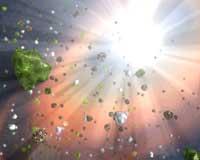Planet Earth, increasingly "fat" or "thinner"?
What would you answer this question? Whenever humans send satellites and other devices into space, or if we take into account the atmospheric water vapor that escapes the planet, one might think that the Earth is "thinning". But the opposite conclusion must also be reached, given that the world population is growing and that from space we receive numerous cosmic powders. So what are we in?

The answer is that the Earth is "getting bigger", that is, the mass of our planet is constantly increasing.
Since the first artificial satellite was launched in 1957, astronauts have turned around the Earth a lot of astronauts. The satellites, the rocket sent to orbit these satellites and the remains thrown into the explosions of spacecraft remain in space. The truth is that the amount of waste that human beings have sent there is much less than the amount of waste that every year reaches Earth from space.
A few years ago, Soviet researchers pointed out that every year 30,000 tons of cosmic waste fall to the earth's surface. Since then, and today, many scientists agree that the amount ranges from 10,000 to 100,000 tons. They are “responsible” for this annual “rise”, both small dust particles and meteorites.

Each year, from space many cosmic residues fall to the earth's surface. ·( Figure: NASA/JPL-Caltech/T. Pyle (SSC).
This amount of waste, logically, is high, but it also seems “insignificant” compared to the total mass of the Earth. Current estimates estimate that our planet has a mass of 5,973 tons — 1798. Physicist and chemist Henry Cavendish mentioned 6,600 tons of trillions in 2006.
Atmospheric water vapor particles move in all directions and some of them reach the highest layers of the atmosphere. There, the force of gravity weakens, so some particles manage to escape into a wide space. However, steam molecules tend, in general, to condense and form mists, returning to the water cycle. In addition, this little water that “leaves us” is compensated by the amount that comes from inside the planet through volcanic eruptions. Thus, the total amount of H2O in the atmosphere remains stable.
Myth, for its part, does not influence the amount of mass on the planet. The great chemist Antoine Lavoisier showed that “matter is not generated and undone, but changes state thanks to chemical processes”. According to him, humans and other living beings are “made” with elements already existing on Earth: carbon, hydrogen, oxygen, nitrogen and phosphorus. That is, that there is more population does not mean that new matter occurs or that the amount of matter increases. Therefore, the mass does not vary either, since the mass is a measured magnitude of the amount of matter of a body.
Confusion of terms

The increase in the world population does not influence the amount of mass on the planet. ( Figure: rp72).
It should be noted that weight and mass concepts are often used confusing in common language, although they are two different physical magnitudes.
The mass is the amount of matter of a body, measured with a balance in kilograms. For its part, weight is the force of gravity exercised by the Earth or by any other body on that mass, measured by that force. It is measured in newtons by a dynamometer. Where there was no gravity, the bodies would have no weight, but they would remain mass.
Thus, the Earth “weighs more” than saying it is more correct to say that its mass has increased. When we also weigh on a scale, after all we are measuring our mass, although the expression “I ask 60 kilos” is common.
Published in 7k
Buletina
Bidali zure helbide elektronikoa eta jaso asteroko buletina zure sarrera-ontzian











